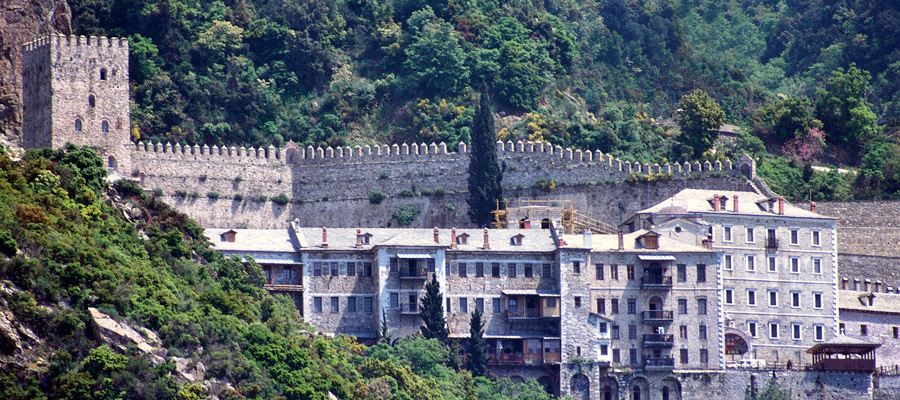Aghiou Pavlou (St Paul) monastery
It is located at the foot of Athos, in the southwestern shores of the peninsula near a large stream. It is a 20 minute walk from the arsana (harbor) and an hour an a half from the neighboring Dionysiou monastery. A fog of legends and traditions cover the founding years. Monks identify Paul of Xiropotamou as the founder who settled there in the middle of the 9th century. Sources reveal its existence under the current name, since 1108. During the centuries, it took its fortress form with the wall, the battlements and the tall defense tower, forming a harmonious architectural complex along with the rocky surroundings. Serb monks Gerasimos, Radonia and Anthony Pegasis restructured it in 1360, after the devastating raids that took place in the 14th century. Serb abbots and Paleaeologeans John G’ and H’ and brothers Giour and Lazarus, supported it financially.
It went into decline during the 18th century and was almost deserted during the Greek Revolution. The time between 1816-1820, monk Anthimos Komninos from Silivria, abbot of the monastery’s dependencies in Romania and friend of Patriarch Gregory V, doubled the building complex, founded the new Catholicon and gifted the monastery properties in Cassandra and Thassos. The last catastrophic event in its modern history was the 1902 fire and the 1911 flood.
The Catholicon celebrates the Ypapanti (Presentation) of Christ and according to testimonies began being built in 1839 and was finished in 1844, on the St. George holiday. Its walls are made of marble and has 14 marble columns with capitals carved in Trieste. John Lyritis of Tinos created the marble “iconostasi” (icon‐screen) in 1901. The Catholicon does not have any hagiographies at present day. The main attractions are the 6 candelabras from Venice and the center bronze chandelier built in 1669 in Dresden.
The shrine of Maro, the daughter of Serb abbot Vrankovic who was married to the Sultan Murad II, is located between the monastery and the arsana (harbor). According to tradition, in 1470, Maro transported and offered the Magicians’ holy presents to newborn Christ via boat. When she disembarked and walked towards the monastery, she heard a voice telling her to stop because there was another queen in Athos, Virgin Mary.
The New Skete, dedicated to the birth of Theotokos in which Nicodemus the Athonite lived as a hermit, depends on the monastery. It also rules the Skete of St. Dimitrios, or Skete of Lakkos, located in the northeastern side of the peninsula, between the monastery and the tower of Morphonou that belonged to the ancient fraternity of Amalfins.
Text: Dr. Antonios G. Dikaios/ Theologian – Environmentalist.






